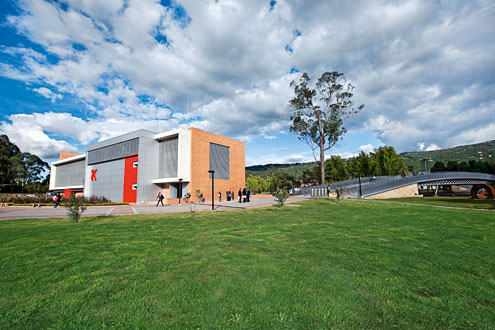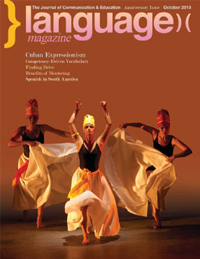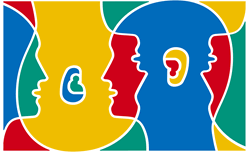South America offers an array of immersion destinations to befit a continent of the future
The common language to more than 20 countries (in the Americas, Spain, and Asia), spoken by more than 400 million people, second only to Mandarin in its number of native speakers — with an additional 60 million speakers as a second language and 20 million students as a foreign language — Spanish is one of the six official languages of the United Nations and is used as an official language by the European Union and Mercosur. Ergo, Spanish is an asset in anyone’s career and cultural growth.
Latin America has gained significant world recognition for its capacity to strive out of an opaque past towards a brilliant future. Economic growth, innovation, cultural richness, biodiversity, fast-growing tourist destinations, and vivacious cities make South America a continent for the future.
Colombia
Colombia, at the northwestern edge of South America, has the third-largest Spanish-speaking population in the world, after Mexico and Spain. It is ethnically diverse, and the interaction between descendants of the original native inhabitants, Spanish colonists, African slaves, and 20th-century immigrants from Europe and the Middle East has produced a rich cultural heritage. This has also been influenced by Colombia’s incredibly varied geography. The majority of the urban centers are located in the highlands of the Andes mountains, but the country also encompasses Amazon rainforest, tropical grassland, and both Caribbean and Pacific coastlines.
In recent decades, Colombia has become a vibrant nation and an attractive destination for its consolidated economy and democracy, as well as its cultural relevance as an up-and-coming place to visit. Building on its natural wealth, the government, hand in hand with the people, has launched outstanding initiatives to make Colombia secure and attractive to foreign investment and tourism. An example of this is the launch of the website spanishincolombia.gov.co, which showcases all the options to learn Spanish in this magical country. To cite a recent campaign: “If you are wondering about the right place for an unforgettable Spanish-learning experience, choose Colombia, where the only risk is wanting to stay.”
As Colombia has grown, Berlitz has grown too. It opened its first language center in Colombia in 1982. Today, it has ten language centers across the country offering people a wide range of services including language instruction, cultural training, specialized language courses, exam preparation, and immersion courses. Berlitz has a strong position in both the consumer and corporate segments, offering clients a true solution for an increasing need in the country: speaking another language. Doors are open to those who want to work, learn, and live in a fantastic cultural experience. As the country continues to grow academically and economically, Berlitz is now broadening its horizons and offering Colombian and foreign clients a world of opportunities.
The Spanish World Institute in Bogotá has adapted its Spanish programs over the years according to the context of daily life in which the students learn how to communicate as natives, while looking for the best teaching tools.
Programs are designed for students of all levels, thanks to personalized learning plans and small-class sizes. The learning process is fast, due to the proper materials to develop each linguistic skill combined with the commitment of their highly educated teachers.
Through elective subjects and activities, the institute also offers the opportunity for students to get into Colombian culture, history, and customs.
In addition, there’s the cultural experience of getting to know Bogotá, Colombia’s capital, and its surrounding areas, renowned for their clear Spanish accent.
EAFIT University’s Spanish Program provides total immersion in Latin American culture and Spanish in Colombia.
EAFIT offers the chance to have daily intensive Spanish lessons at a vibrant university campus surrounded by the friendliest people. Living with a local host family helps students boost their command of the language and get to know Latin American culture. The EAFIT University program in Medellín is internationally accredited by the Cervantes Institute and ACCET, ensuring quality Spanish language training. Outside of class, students can connect with conversation partners who help with the acquisition of colloquial language.
Medellín is one of the world’s most exciting cities. Students get to know Colombia and its culture through mixing with the locals and traveling in the region. Studying there is an exhilarating way to improve Spanish proficiency and become a part of the local culture.
Founded in 1991, the language center offers high-quality language programs based on the communicative approach. Students can choose from classes that last two weeks, four weeks, or ten weeks. The center also offers a conversation program that provides participants with the opportunity to practice Spanish with native speakers on a one-to-one basis. The center’s cultural orientation programs also allow students to become familiar with Colombia’s diverse culture.
The Universidad Tecnológica de Bolívar offers a communicative, content-based, four-skills approach to learning Spanish through three competency levels: basic, pre-intermediate, and intermediate.
Course design is based on adult learning principles and second-language teaching techniques. Materials include Protagonistas Student Activities Manual.
The program’s expert teachers are Colombian, are Instituto Cervantes certified, hold university degrees, and use the most up-to-date teaching methods.
The Open Access Language Center designed the Español para Extranjeros program to promote Spanish language learning and the Colombian Caribbean culture.
The basic program requires no prior knowledge of Spanish. Through a variety of learning modules, students will learn to describe basic needs and to understand and use common everyday expressions, along with simple sentences aimed at speaking in any location in the Spanish-speaking world.
The pre-intermediate program (120 hours) gives students sufficient linguistic competence to understand and appropriately respond to the most common situations of everyday life and to communicate wishes and needs in a basic manner. Students speak the language, read general texts and simple literary texts, and write letters and compositions on general aspects of everyday life.
The intermediate program (150 hours) enables student to get by in most everyday situations that don’t require any specialized use of language. Students are able to argue points of view, present arguments, and use idiomatic expressions or other stylistic resources that allow a creative use of the language. Students speak, write, and read comfortably.
Vive Español is a Spanish program run by Universidad de La Sabana´s Department of Foreign Languages and Cultures in Chia , Colombia. The main objective of the program is that students learn the language and improve communicative competences by working in the four language skills.
The program has eight different courses that students can choose from: General Spanish, Spanish for Tourism (conversational), General Spanish and Volunteer work, Spanish for Business Meetings, Spanish for Professionals (Business, Medicine, Law and Aviation), Tailor-made Spanish programs for companies, summer courses, and private lessons. The programs are flexible so students can choose when to start and for how many weeks.
All the facilities on campus such as the library, the university clinic, sports fields, and restaurants are shared with Spanish students. Accommodation and transportation assistance is provided by a dedicated support team. Students can take dance and culture classes at no additional cost.
Ecuador
With the Amazon rainforest occupying almost half of its territory and the nearby Galapagos Islands beckoning, Ecuador is a paradise for the adventurous types. The Yasuní National Park, declared an International Biosphere Reserve by UNESCO in 1979, flourishes with thousands of tree species and over 600 bird species. Surfers can ride the wave of Montañita on the southern coast. Ecuadorians are known for their awe-inspiring artisanal crafts and friendliness.
Spanish teachers bring language to life when they travel to Ecuador with their students. Intercultural Student Experiences’ (ISE) educational travel program to Ecuador immerses students in the language and culture. The itinerary provides numerous and intentional opportunities for students to engage with Ecuadorians and speak Spanish. A local guide accompanies the group full time, providing valuable insights into the culture and language. After morning Spanish classes at Academia Guayasamín, students practice what they’re learning while exploring fascinating Quito, the capital city. With one foot in each hemisphere, students walk the equator line during an excursion to La Mitad del Mundo. A visit to Otavalo, South America’s largest handicraft market, is a treat for the senses and provides countless opportunities to speak Spanish, learn about Ecuadorian textile art, and sample the regional cuisine. Students deepen their experience of Quiteño culture and stretch their language skills while living with host families for five days, enjoying meals at home, and participating in a cooking class. An optional four-day excursion to the Galápagos Islands includes opportunities to snorkel and swim with sea lions, witness spectacular volcanoes, and visit the Charles Darwin Research Station.
Peru
Peru has long been a favorite destination of students and backpackers alike. With its iconic Machu Picchu ruins of the great Inca empire, breathtaking mountainous landscapes, and impressive coastline, Peru has much to offer.
Peru’s cuisine is becoming increasingly praised internationally, as quinoa has been dubbed a superfood and ceviche is a staple at many seafood restaurants around the world. Nikkei, a unique fusion of Peruvian and Japanese cuisine also growing in popularity, is another reason to visit Peru.
Peru boasts a mixture of the modern and the ancient. Lima, the cosmopolitan capital, offers countless cultural events and attractions. Meanwhile, the Incan ruins and mountains tell of a pre-Colombian past. With Peruvian language schools scattered about the country, any student can find an ideal setting for language study abroad.
What country is home to one of the New Seven World Wonders, is the world’s number one culinary destination, and offers great surfing, mountain climbing in the Andes, and exotic Amazonian adventures? Answer: Peru. The most popular destination in South America for Hands-on Spanish Travel (HOST)’s secondary educational travel and study abroad programs, Peru has it all. HOST’s platform for meaningful culturo-linguistic immersion travel allows students and faculty to truly live the reality and royalty of Peru. HOST travelers live with top-ranked host families in Lima and engage in HOST’s signature Three-Way Collaborative Action Projects (3-Way CAPs), where they collaborate with a Peruvian sister school to advance projects at a third institution, usually a school or orphanage in need. HOST’s philosophy of travel revolves around an intimate abroad experience with purposeful culturo-linguistic immersion, sustainable tourism practices, and programming that fosters cross-cultural competence, resulting in educational travel that makes a difference.
Cross-Cultural Solutions is a nonprofit organization that enables volunteers to make a meaningful contribution to the community by working side by side with local people while gaining a new perspective and insight into the culture and themselves. The volunteer work is with carefully selected local organizations, all of which are dynamic and inspiring community-led initiatives. The CCS experience also includes cultural and learning activities so that volunteers can learn about the local culture. These include an in-depth orientation, language training, guest speakers, and more. There is also plenty of free time to relax, reflect, or explore the community. Volunteers enjoy the flexibility of choosing from twelve countries, start dates year-round, and programs from one to twelve weeks long. CCS offers international volunteer programs in Brazil, China, Costa Rica, Ghana, Guatemala, India, Morocco, Peru, Russia, South Africa, Tanzania, and Thailand.
You know about Machu Picchu and the Inca trail. Now, with Caminante Spanish School, say “hola” to the rest of this amazing country. They have eleven branches around Peru located in the jungle, on the coast, and in the mountains. Caminante Spanish Home School can offer students a unique fulfilling experience. Caminante believes in an immersion and cultural program in which students do most of their communication in Spanish; the program confidently states that living and studying with a host family is the most efficient system for learning a language. Their immersion program focused on living and studying in a host family or teacher’s house is the first school in Peru of its kind. Caminante Spanish Home School lessons are suitable for all ages from three-years-old and up. Students can choose the dates which suit them as the program operates all the year round; they can also choose the hours of teaching per week and stay as many weeks as they like. Caminante offers a variety of programs to meet students’ needs, including individual and group lessons. Their volunteer program is focused on helping students find volunteer projects where they can put their Spanish into practice, along with their professional knowledge and their desire to help others.
Peruwayna is a private Spanish language school in the bustling heart of Lima, Peru, that aspires to be the best language school in South America. Ninety percent of their teachers have completed a graduate specialization degree in teaching Spanish as a foreign language, all instructors are certified examiners for the DELE international exam in accordance with the requirements of the Instituto Cervantes, and all programs are in accordance with the European framework of reference for languages. Peruwayna offers a wide variety of classes, from survival Spanish for travelers to advanced courses for serious students, as well as extracurricular activities that make learning fun and help students appreciate Peruvian culture. Peruwayna has partnerships with numerous local businesses for the benefit of students, arranges various housing options for independent travelers, and organizes several events per week taking students to different cultural sites in and around Lima. Finally, what sets Peruwayna apart is the dedication and passion of its staff, and it is their goal to make sure that every student not only learns the most Spanish possible, but also becomes part of their warm and caring community.
Chile
Chile boasts an excellent university system, a seemingly endless coastline, and one of the world’s finest wine regions. It’s no wonder year after year thousands of students flock to Chile for studies and for fun. On a given day in Chile, some may be skiing and others may be surfing and sunbathing. The country’s interesting geography, ranging from the dry Atacama Desert to Patagonia with temperate climates in between, makes Chile a country where students can enjoy a plethora of outdoor activities regardless of the season.
Chile’s rich literary history and tumultuous political past will attract students who seek a striking cultural context for their Spanish language studies. Between its history, culture, and beautiful geography, Chile is an ideal place for all types of students.
The primary mission of the Instituto Chileno de la Lengua Instituto Chileno de la Lengua (ICHIL) is teaching Spanish to foreigners who come to Chile. To fulfill this mission, ICHIL is committed to the educational level of each teacher — all of whom have university degrees and significant teaching experience. For example, before being hired by ICHIL, each teacher must attend classes and then teach at all course levels at the Institute. This allows ICHIL’s management to see if students respond positively to their methods and approach — and thus ensures the quality of language education throughout the Institute. ICHIL offers the possibility to learn or improve one’s level of Spanish in the heart of Santiago, one of the most dynamic and attractive capitals in Latin America. The objective of all the Institute’s Spanish courses is to help students and professionals learn the basics or strengthen and improve their Spanish. ICHIL focuses on the challenges posed by grammar — addressing progressive degrees of potential difficulty, and ultimately giving all students the means to meet head-on the challenges they will face in daily life and work. To achieve these objectives, ICHIL offers four levels of teaching: elementary, intermediate, advanced, and confirmed.
Ecela operates two schools in Chile, one in Santiago, and another in coastal Viña del Mar. Clients can easily combine the schools as they use the same curriculum and schedule.
Ecela Santiago occupies a restored white and blue mansion on a quiet side street in Providencia. Conveniently located, students enjoy easy access to cultural hubs as well as social meeting points.
Ecela Viña del Mar is a smaller school and is located just a few blocks from the beach. It is also easy to get to neighboring Valparaiso, a little gritty but fabulous for photography.
Top-ranked instructors lean on the “intensive” side of the teaching spectrum. Those looking for a very relaxed experience can be intimidated by the pace and might prefer a more informal, “backpacker” option.
The student population breakdown is about 25% each of Americans, Brazilians, Europeans, and “elsewhere.” About half are under 25, 10% are seniors.
Academia de Idiomas del Norte (AIN) has been teaching Spanish as a Foreign Language in sunny northern Chile since 1980. The language school is Swiss-owned and located in the coastal city of Iquique, a summer resort and port in the north of the country.
The school has a list of carefully chosen accommodations. Students are picked up at the airport or bus stations and looked after throughout their entire stay. Students enjoy small class sizes or individual lessons, and afternoons free to tour the city, visit the beach, or head to the hills of the nearby Atacama Desert to sandboard.










